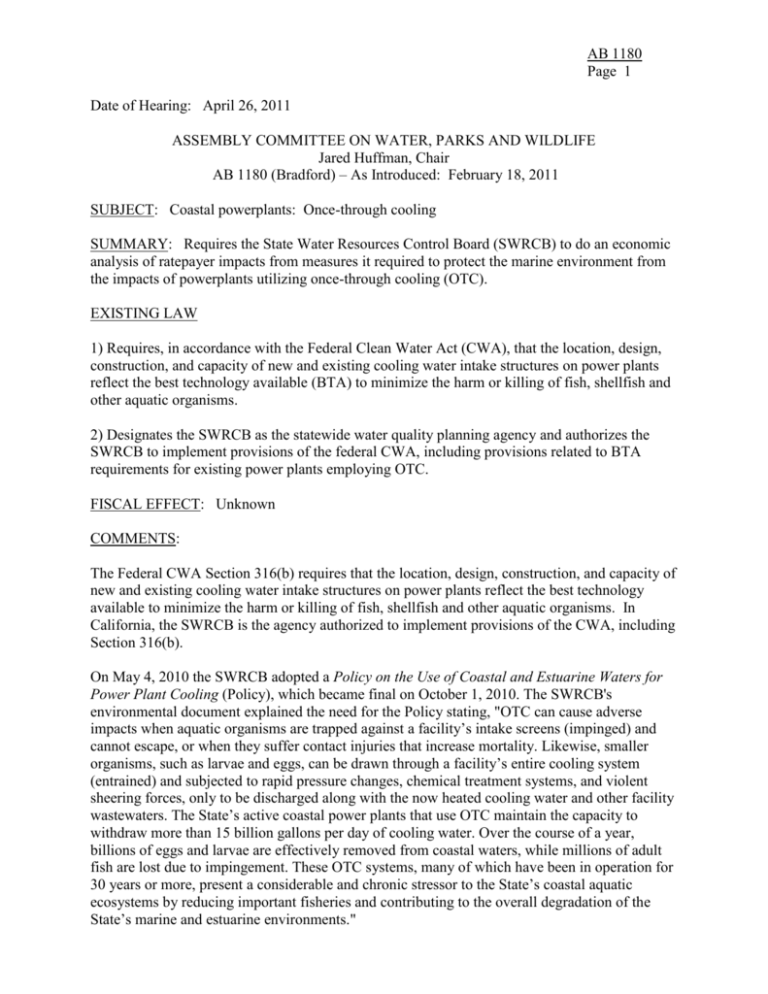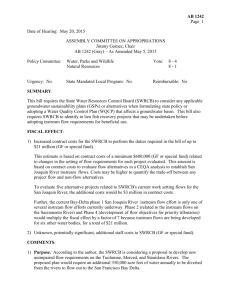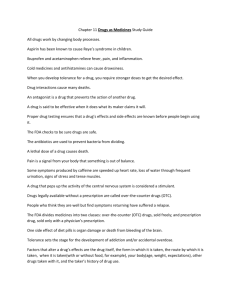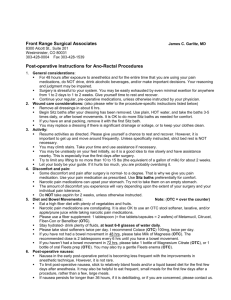Microsoft Word version
advertisement

AB 1180 Page 1 Date of Hearing: April 26, 2011 ASSEMBLY COMMITTEE ON WATER, PARKS AND WILDLIFE Jared Huffman, Chair AB 1180 (Bradford) – As Introduced: February 18, 2011 SUBJECT: Coastal powerplants: Once-through cooling SUMMARY: Requires the State Water Resources Control Board (SWRCB) to do an economic analysis of ratepayer impacts from measures it required to protect the marine environment from the impacts of powerplants utilizing once-through cooling (OTC). EXISTING LAW 1) Requires, in accordance with the Federal Clean Water Act (CWA), that the location, design, construction, and capacity of new and existing cooling water intake structures on power plants reflect the best technology available (BTA) to minimize the harm or killing of fish, shellfish and other aquatic organisms. 2) Designates the SWRCB as the statewide water quality planning agency and authorizes the SWRCB to implement provisions of the federal CWA, including provisions related to BTA requirements for existing power plants employing OTC. FISCAL EFFECT: Unknown COMMENTS: The Federal CWA Section 316(b) requires that the location, design, construction, and capacity of new and existing cooling water intake structures on power plants reflect the best technology available to minimize the harm or killing of fish, shellfish and other aquatic organisms. In California, the SWRCB is the agency authorized to implement provisions of the CWA, including Section 316(b). On May 4, 2010 the SWRCB adopted a Policy on the Use of Coastal and Estuarine Waters for Power Plant Cooling (Policy), which became final on October 1, 2010. The SWRCB's environmental document explained the need for the Policy stating, "OTC can cause adverse impacts when aquatic organisms are trapped against a facility’s intake screens (impinged) and cannot escape, or when they suffer contact injuries that increase mortality. Likewise, smaller organisms, such as larvae and eggs, can be drawn through a facility’s entire cooling system (entrained) and subjected to rapid pressure changes, chemical treatment systems, and violent sheering forces, only to be discharged along with the now heated cooling water and other facility wastewaters. The State’s active coastal power plants that use OTC maintain the capacity to withdraw more than 15 billion gallons per day of cooling water. Over the course of a year, billions of eggs and larvae are effectively removed from coastal waters, while millions of adult fish are lost due to impingement. These OTC systems, many of which have been in operation for 30 years or more, present a considerable and chronic stressor to the State’s coastal aquatic ecosystems by reducing important fisheries and contributing to the overall degradation of the State’s marine and estuarine environments." AB 1180 Page 2 The stated intent of the Policy "is to ensure that the beneficial uses of the State's coastal and estuarine waters are protected while also ensuring that the electrical power needs essential for the welfare of the citizens of the State are met." The Policy acknowledges there are no applicable nationwide standards for implementing CWA Section 316(b) for existing power plants and establishes technology-based measures to reduce the harmful effects associated with cooling water intake structures on marine and estuarine life. The Policy applies to the 19 existing power plants (including two nuclear plants) that currently employ a single-pass system, also known as OTC. Under the Policy, "closed-cycle wet cooling" has been selected as BTA. Unlike OTC, which draws cool water and living organisms from the ocean and then discharges warm water back into it, closed-cycle wet cooling recirculates the same water but uses cooling towers or other means to reduce its temperature for reuse. The SWRCB's Policy has been in development for at least five years. Phase I of the Policy addresses new power plant units. However, the most contentious issues have centered on Phase II, which applies to existing OTC units. On December 7, 2005 the SWRCB held a Phase II 316(b) Workshop in Oakland, California. Various presentations were made concerning the degree of OTC impacts, technologies for compliance, and issues of cost. For example, one group, the California Council for Environmental and Economic Balance (CCEEB), questioned the biological significance of OTC effects and warned that there were very high retrofit costs and increased operating and maintenance costs associated with converting existing OTC units to wet/dry cooling tower systems. CCEEB gave retrofit cost estimates for the Los Angeles Department of Water and Power (LADWP) San Onofre Nuclear Generating Station of $465$500 million to change to dry cooling and $205-$400 million to change to wet cooling. On April 17, 2006 the California State Lands Commission adopted a Resolution regarding California OTC power plants. The Resolution states that the Commission shall not approve leases for new power facilities, leases for re-powering existing facilities, or extensions or amendments of existing leases for existing power facilities whose operations include OTC, unless the power plant is in full compliance, or engaged in an agency-directed process to achieve full compliance, with requirements imposed to implement both CWA § 316(b) and California water quality law, and with any additional requirements imposed by state and federal agencies for the purpose of minimizing the impacts of cooling systems on the environment. The Resolution also states that the Commission shall include in any extended lease that includes OTC systems a provision to consider re-opening the lease, if an alternative, environmentally superior technology exists that can be feasibly installed. In 2006 and twice in 2008, the SWRCB held public meetings to discuss the scope, content and environmental analysis for the § 316(b) Policy. Thereafter, on April 14, 2009, Senator Corbett introduced SB 42, which prohibited state agencies from authorizing, approving, or certifying new powerplants or industrial facilities using OTC and requiring the phase-out of certain OTC facilities by January 1, 2015. SB 42 was later amended to remove the phase-out of existing OTC facilities and instead require the payment of a per gallon mitigation fee. In its analysis of SB 42, the Senate Energy, Utilities and Communications Committee stated, "This mandate would jump ahead of the SWRCB's work on developing a statewide policy and undermine its work product." SB 42 was held in Committee. On July 9, 2009 the SWRCB issued notice that it would hold a September 16, 2009, hearing on a proposed Policy and requested comments. In response, over seventy groups and individuals, representing community organizations, environmental protection, industry, state and federal AB 1180 Page 3 agencies, and the California Senate sent letters. In its letter the LADWP claimed "impingement and entrainment losses [from OTC] are not a significant factor causing declines to California's coastal fisheries" and that "OTC compliance costs will be several hundreds of millions of dollars for LADWP, and according to a NERA [economic consulting] report, over $3 billion dollars to the electric utility industry" and suggested the SWRCB adopt a "site-specific cost-benefit analyses" in its Policy. Environmental groups, on the other hand, maintained that there were "4050 years of marine life impacts due to OTC, where adjacent ecosystems have suffered a long history of entrainment and impingement. Eliminating this significant impact on marine life may allow depleted or 'overfished' species to recover to population abundance well beyond what we see in population assessments today." As reference above, the SWRCB adopted its Policy on May 10, 2010 and submitted it on August 10, 2010 to the Office of Administrative Law (OAL) for approval. The Policy recognized that because the "Los Angeles region presents a more complex and challenging set of issues, it is anticipated that more time would be needed to study and implement replacement infrastructure solutions." The Policy allowed the Greater Bay Area and San Diego regions until 2017 to comply while providing the Los Angeles region until 2020. On August 20, 2010 while the SWRCB Policy was pending with OAL, the Assembly Committee on Utilities and Commerce gutted and amended a Committee bill, AB 1552, in order to allow municipally-owned coastal powerplants until December 31, 2031 to comply with the SWRCB's Policy. AB 1552 was later withdrawn. On September 30, 2010 the SWRCB issued notice that it would consider a proposed amendment to the Policy and invited public comment. Among other provisions, the proposed amendment would have allowed the LADWP Haynes Generating Station and Harbor Generating Station and the Dynegy Moss Landing Power Plant, under certain circumstances, to continue to use OTC until their units reached the end of their useful life and to, instead, submit mitigation funds in the amount of three dollars per million gallons of water withdrawn, payable annually. In response, over sixty groups and individuals, representing community organizations, environmental protection, industry, federal agencies, and others sent letters. At its December 14, 2010 hearing the SWRCB rejected the amendment. Under the SWRCB Policy, a Statewide Advisory Committee on Cooling Water Intake Structures (SACCWIS) was created to "ensure that implementation plans and schedules established by the Policy are realistic and will not cause disruption to the State’s electrical power supply." The SACCWIS includes representatives from the California Energy Commission, California Public Utilities Commission, California Coastal Commission, California State Lands Commission, California Air Resources Board, California Independent System Operator, and the SWRCB. One task of the SACCWIS is to review the implementation plans and schedules that power plant owners and operators were required to submit by April 1, 2011 to ensure that the deadlines in the Policy account for local area and grid reliability, including permitting constraints. The SACCWIS must report to the SWRCB with recommendations no later than October 1, 2011. The SWRCB may then direct staff to amend the Policy, if needed. The SACCWIS will continue to meet and provide annual reports to the State Water Board until the Policy has been fully implemented. On April 1, 2011, LADWP submitted a 54-page Implementation Plan (IP) to the SACCWIS. In that IP, LADWP requested to be allowed to replace its OTC units on an extended schedule at a sequenced "pace of two repowers per decade" based on a unit-by-unit rather than a facility basis AB 1180 Page 4 with the final unit coming off-line in approximately 24 years, providing there are no delays in the process. The LADWP IP also addressed demographics and rates in the Los Angeles area stating that "nearly three quarters of a million individuals (725,196), or about 19.1% of Angelenos, live in poverty." The IP asserts that the average median household in the City of Los Angeles ($48,570) is lower than the statewide median and also other service territories such as San Diego Gas & Electric ($60,354) and Southern California Edison ($57,033). The IP closes by advising that due to the "demographics of the City of Los Angeles, even moderate rate increases will have a severe impact on LADWP's ratepayers. Rate increases that may result from OTC compliance will be in addition to baseline rate increases intended to cover fuel, operation and maintenance costs." Support Arguments: Supporters state this bill is needed in order to require the SWRCB to determine the potential cost to utility rate payers of the Policy, including the timelines for implementing the Policy, and for state regulators and state agencies to better assess the relationship between new regulations placed on utilities and the funding sources, often increased utility rates, used to comply with those regulations. Opposition Arguments: The opponents of this bill state that it will require the SWRCB to spend extremely scarce funds to conduct analyses that have already been completed in depth as part of the extensive process used to adopt the Policy. Opponents state that economics and ratepayer impacts were specific elements of two separate independent studies incorporated into the Policy's Substitute Environmental Document, which itself provided assessments of cost increases to ratepayers under different industry scenarios. SWRCB staff indicate approximately $556,000 was previously spent conducting two economic impact analyses of the draft Policy, not including staff time. SWRCB Staff indicate an additional $300,000 and one staff person would be needed to implement this bill. Suggested Amendments: In light of the concerns raised by SWRCB Staff, the author and the Committee may wish to consider an amendment that eliminates the requirement for an economic report but instead provides LADWP with a date certain as to when the SWRCB may, or may not, amend the Policy with respect to municipally-owned power plants. REGISTERED SUPPORT / OPPOSITION: Support Anthony California Chamber of Commerce E Street Cold Logistics Robert Smola, President Konoike-Pacific Opposition California Coastkeeper Alliance California League of Conservation Voters Clean Water Action California Heal the Bay Natural Resources Defense Council Orange County Coastkeeper See's Candies The Downtown Properties The Trident Center Pacific Coast Federation of Fishermen's Assocs. Pacific Environment Planning and Conservation League Sierra Club of California Southern California Watershed Alliance Surfrider Foundation The Ocean Conservancy Analysis Prepared by: Tina Cannon Leahy / W., P. & W. / (916) 319-2096






